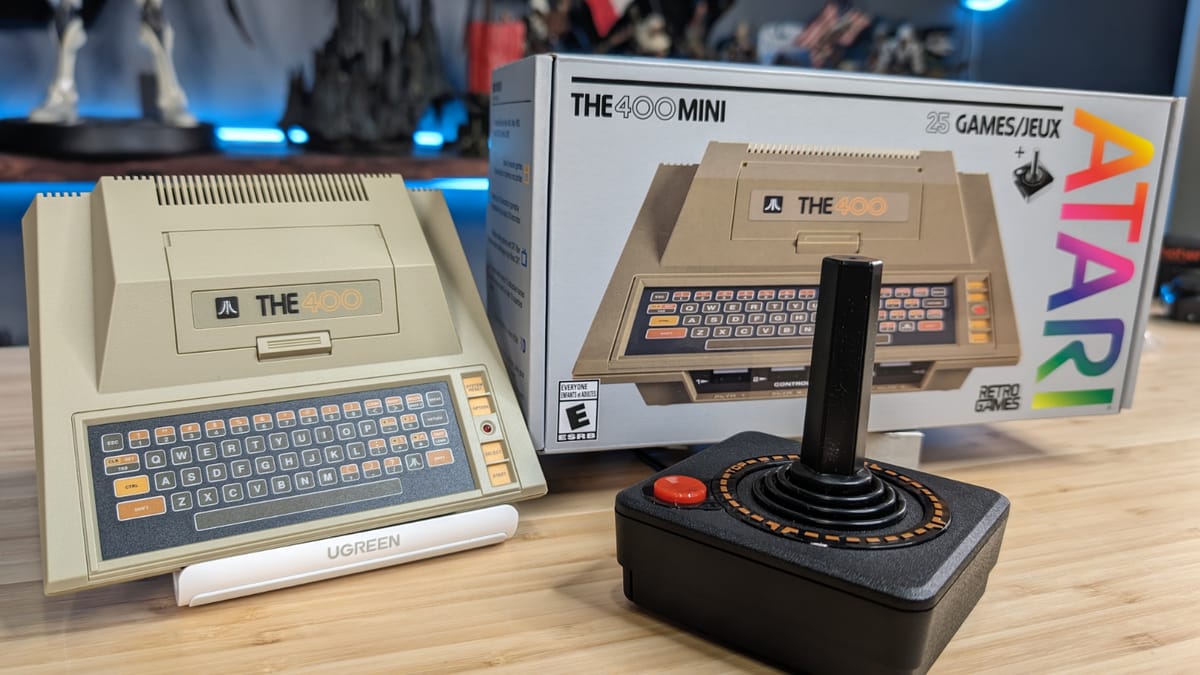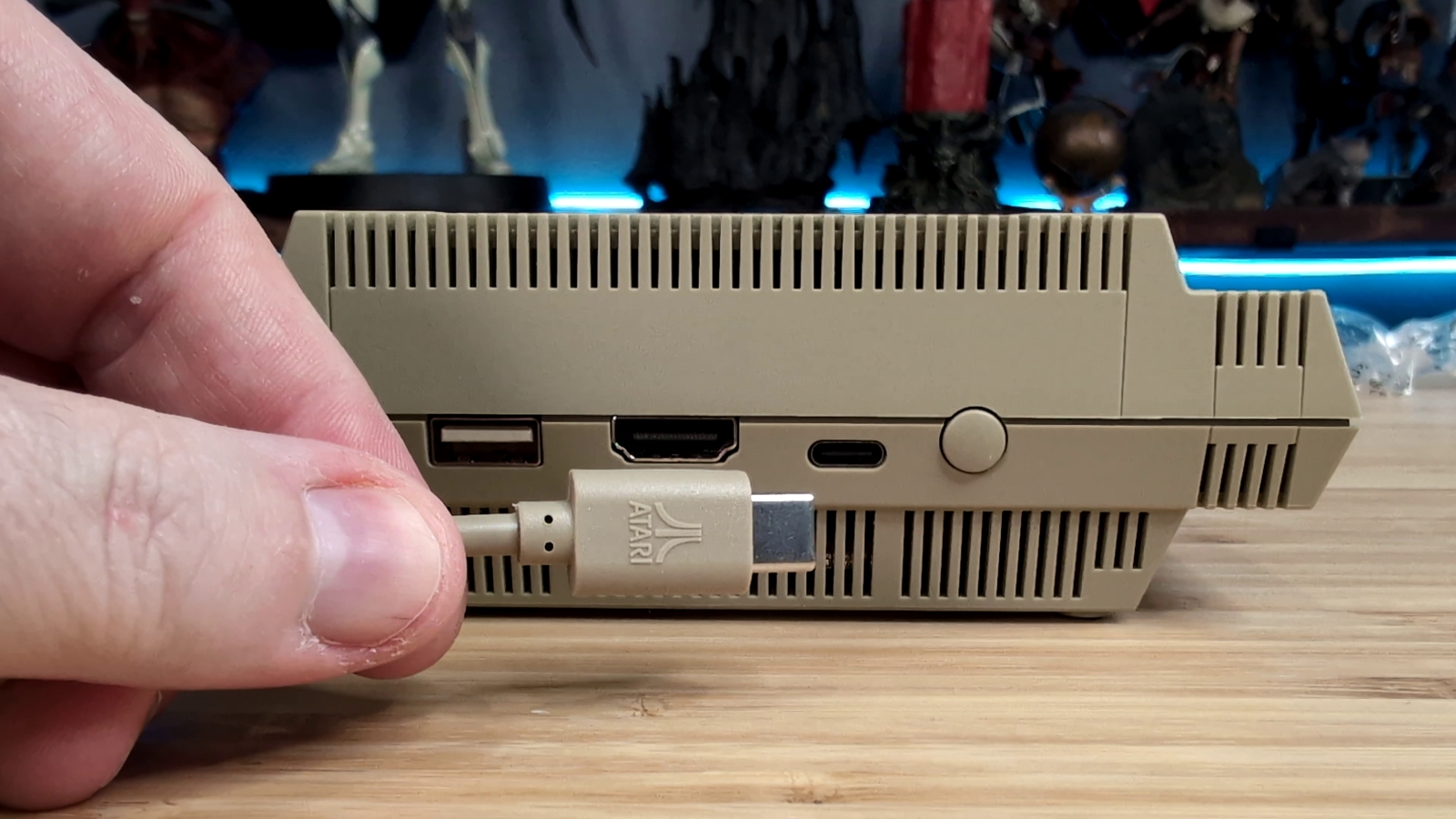
My first game console had wood grain. If you can immediately bring to mind exactly what I’m talking about, you likely owned an Atari 2600. You might be interested to know that it was far from Atari’s first foray into the 8-bit market, though. For that, you’ll have to look to the Atari 400 in 1978, the Atari 800 in 1979, the XL and XE, and both the Atari 5200 and Atari 130XE which all predate that storied console. Arguably, it’s where Atari started, and for a great many, the source of innumerable fond memories of games like Frogger, Defender, Adventure, and many more. Today we take a look at The Atari 400 Mini from Retro Games Ltd, a retro console poised to resurrect that same nostalgia in all of us – with 25 games preloaded – and a simple method to load any other games you’ve legally obtained. While it’s hardly the most powerful mini retro console on the market, it’s also a slice of many people’s childhood, including my own. My anticipation has peaked, so let’s get this out of the box!
This thing is tiny, as you’d expect from a retro console, but that doesn’t mean it’s not adequately powered. It has an ARM Cortex A7 processor, 256MB of RAM, and 128MB of flash memory. Sure, that’s paltry compared to even a cell phone, but you could hold several hundred Atari games in that amount of RAM and not bat an eye. What it means is that a game will run as fast or as slow as it originally ran, comfortably output at 720p, and with plenty of power to spare.
If you remember when you once had to place two tiny little forks on a pair of screws to add a sliding TV adapter into the mix for your Atari, you’ll be happy to know that the 400 mini opts for a simple HDMI output to a modern television. The whole device is powered with a 5V 1A USB-C cable, so it’ll practically run off a trickle charger. Both of the cables are the same Atari brown as the console itself, and both are branded with the Atari logo.

There are a total of five USB-A ports on the 400. Included in the box is the CXStick, a replica of the original Atari joystick, albeit hiding a few more buttons. This USB controller plugs into any of the ports, though it makes the most sense to plug it into the front. You can also use paddles, the 5200 controller, and other USB-powered controllers, though I haven’t tested them all for compatibility. I was able to use PS4, PS5, and Xbox Series X, and an 8Bitdo controller with a USB cable, so it seems like just about any input will do, though frankly I wanted to stick with the real McCoy for the pure experience. The big red fire button makes a clacky sound, just like the original, though a small shoulder button hidden in the upper left of the housing does the same function, albeit far quieter. Around the stick is actually a ring of four directional buttons that blend into the original aesthetics of the joystick. Two tiny buttons for navigation join the others, operating as a start and menu button, respectively.
The console itself is tiny, as you’d expect. It’s also perfectly modeled after the larger version of the device, complete with all of the function buttons on the side, with a perfectly matched brown paint job of the original. The only thing missing here is the cartridge opening at the top. It means you won’t be able to use your cartridges if you still have them, but that’s not the only way to play. Let’s talk about what’s included, and then about what you can do to add to it.

The complete list of what is preloaded on the device is as follows:
Basketball (1979)
Asteroids (1981)
Centipede (1981)
Missile Command (1981)
Miner 2049ier (1982)
Berzerk (1983)
Bristles (1983)
Capture the Flag (1983)
Encounter! (1983)
Flip and Flap (1983)
M.U.L.E. (1983)
O’Reily’s Mine (1983)
Wavy Navy (1983)
Hover Bover (1984)
Lee (1984)
Millipede (1984)
The Seven Cities of Gold (1984)
Boulder Dash (1985)
ElektraGlide (1985)
Battlezone (1987)
Henry’s House (1987)
Star Raiders II (1987)
Airball (1988)
Crystal Castles (1988)
Yoomp! (2007)
There are some true classics in this list, but a few big names I’d consider to be missing as well. The 400 Mini can handle a number of formats, covering everything from the 400 to the 5200 home console. That means .cas, .atr, .atx, .xfd, .dcm, .com, .xex, .crt, .rom, .bin, .c##, and .m3u are all supported, including multi-disk games like Ultima and Prince of Persia. Any game you’ve legally obtained from those consoles can be simply extracted onto a FAT32-formatted USB drive and then plugged into the device. These games will then appear in a list with a USB symbol on the main menu. Sure, you don’t get the fancy artwork and descriptions like you do with the included games, but they work just the same.
I appreciate what Retro Games Ltd. has done here. Every other mini console maker pretends they aren’t laughably easy to hack. Here they’ve left the system wide open, ready to accept user-loaded games, and making it an easy process. This allows players to enjoy the games they remember without having to potentially brick their system to do it. As a result, I’m able to play the likes of Karateka (our review of the Making Of series below right here), Donkey Kong and Donkey Kong Jr., Pitfall and Pitfall II: Lost Caverns, Joust, Bezerk, and the aforementioned Ultima III: Exodus and Ultima IV: Warriors of Destiny. There are literally thousands of compatible games, and many that are worth a revisit, even today.
If you’ve ever used an emulator to play a game, there’s a save state function that can help you beat your favorite impossible title. This functionality has made its way here as well, giving you four save slots to play with. This can allow you to beat longer games that may not support a real save function, or if you just need to pause your game and come back to it later. I found myself using it a great deal more than expected for a day and age where save files were practically non-existent. For games where saves aren’t as useful, there’s also a 30-second rewind feature, so you can zip back and re-attempt a difficult jump until you finally get it right. Best of all, these rewind and save functions work for USB-added games just fine.
Beyond the save states, there are also a handful of display options available. You can switch to a 4:3 aspect ratio, place a matte over the edges with several patterns, enable scanlines, or even toggle “pixel perfect” mode that is meant to give the games their original look. It’s another trip down memory lane, providing options for purists and modernists alike.
The only real downside to The 400 Mini is that it’s expensive. At $119, it stands shoulder to shoulder with the NES, Genesis, and PlayStation mini consoles in terms of price. As much as I love Karateka, the price of this console might be a bit stiff. That said, The 400 Mini is an absolutely flawless representation of the console it has miniaturized. That might be worth it to the old folks like me who grew up with these nostalgic memories. For me, the smile as I picked up the joystick was worth the price of admission.
The 400 Mini
Excellent
Every one of these retro mini consoles are a looking glass into the past. Each one also has a mix of good, bad, and completely unknown games, but only The 400 Mini has understood the homework. It delivers some of the platform’s very best, while enabling users to easily backfill any others they might want to relive. The 400 Mini is a great start to Atari’s back catalog. Now I’m hoping for a Jaguar / Jaguar CD to round out my Atari retro console library!
Pros
- Retro controller included, with a few enhancements
- Multiple consoles supported
- Loading new content is incredibly simple
- 1:1 perfect emulation
- I can play Karateka again!
Cons
- I wish you could add artwork for added games
- A little pricey
- I’m sad I can’t use carts
